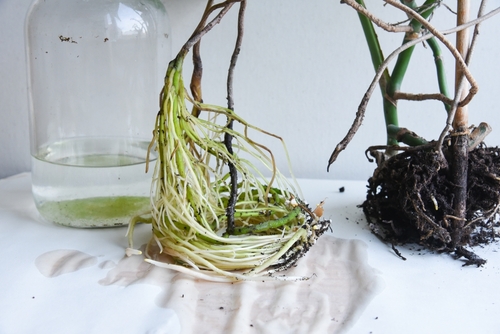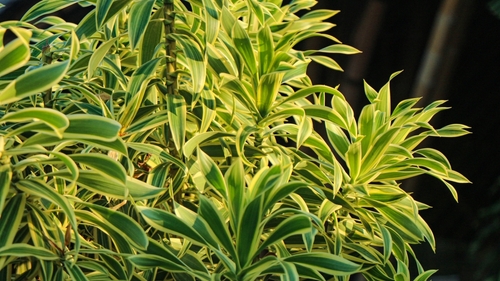The Song of India plant, also known as Dracaena reflexa, is a popular evergreen indoor plant that is loved for its ornamental value and air-purifying qualities. However, despite its hardiness, it is not uncommon for this plant to start showing signs of distress, such as yellowing leaves, drooping stems, or even dying.
If you are a plant parent, you may have experienced the frustration of seeing your Song of India plant dying, despite your best efforts to care for it. In this article, we will explore the common reasons why Song of India plants die, and what you can do to prevent or remedy these issues.
Understanding the Song of India plant is essential to caring for it properly. This plant is native to Madagascar, Mauritius, and other tropical regions, and it thrives in warm, humid environments. It can grow up to 6 feet tall, with long, narrow leaves that are variegated with green, yellow, and cream.
The Song of India plant is a slow grower, and it can take years to reach its full height. However, it is known to be a hardy plant that can adapt to different lighting conditions and soil types. Despite its resilience, the Song of India plant can still fall victim to various environmental factors, diseases, and pests that can cause it to wilt and die.
Key Takeaways on Song of India Plant Dying
- The Song of India plant is an evergreen indoor plant that is loved for its ornamental value and air-purifying qualities.
- Understanding the Song of India plant is essential to caring for it properly, as it is known to be a hardy plant that can adapt to different lighting conditions and soil types.
- The common reasons why Song of India plants die include overwatering, underwatering, poor soil quality, pests, diseases, and environmental stress. Proper care, such as providing ideal conditions for growth, recognizing and treating diseases, and propagating the plant, can help prevent or remedy these issues.
See other reasons why your favorite houseplants might be dying & how to revive them:
Understanding the Song of India Plant

The Song of India plant, also known as Dracaena reflexa or Pleomele reflexa, is a tropical evergreen shrub native to Madagascar and other islands in the Indian Ocean. It is a robust plant that can grow up to 6 feet tall indoors and up to 18 feet tall outdoors in tropical climates.
The Song of India plant has lanceolate leaves that are about 12 inches long and 2 inches wide. The leaves are glossy and have chartreuse stripes that run parallel to the veins. The leaves grow in a whorled arrangement at the top of the stem, giving the plant a unique and attractive appearance.
There are several cultivars of the Song of India plant, including variegated varieties that have yellow or cream-colored stripes on the leaves. These cultivars are highly sought after by plant enthusiasts and can be more difficult to care for than the standard green variety.
The Song of India plant is a popular houseplant due to its attractive appearance and ease of care. It prefers bright, indirect light and well-draining soil. It can tolerate some drought but should be watered when the top inch of soil is dry to the touch.
Although the Song of India plant is generally easy to care for, it can be susceptible to root rot if overwatered or planted in soil that doesn’t drain well. It can also be prone to spider mites and mealybugs, which can be treated with insecticidal soap or neem oil.
Ideal Conditions for Growth
The Song of India plant is a fairly easy-to-grow houseplant that can add a touch of tropical elegance to any indoor space. To ensure that this beautiful plant thrives, it is important to provide it with the right growing conditions.
1. Indoor Environment
The Song of India plant can be grown indoors, making it an ideal choice for apartment dwellers or those with limited outdoor space. It prefers a bright, indirect light, so placing it near a window that receives plenty of natural light is recommended. However, direct sunlight should be avoided as it can scorch the leaves.
2. Temperature and Humidity

The ideal temperature range for the Song of India plant is between 65 and 75 degrees Fahrenheit. It can tolerate slightly cooler temperatures in the winter months but should be kept away from drafts or cold air. This plant prefers high humidity levels, so it may benefit from being placed in a bathroom or near a humidifier.
3. Watering and Soil
The Song of India plant is fairly drought-tolerant and can survive in near-drought conditions. It is important to allow the soil to dry somewhat between waterings to prevent overwatering, which can lead to root rot. The plant prefers well-draining soil that is rich in organic matter.
4. Easy to Grow
The Song of India plant is an easy-to-grow houseplant that can thrive in a variety of growing conditions. With the right amount of light, water, and humidity, this plant can grow quickly and produce lush, green foliage. It is also tolerant of low-light conditions, making it an ideal choice for those with less-than-ideal growing conditions.
Watering and Humidity Requirements
The Song of India plant requires less water than most indoor plants. Overwatering can cause root rot, which can lead to the plant’s death. The soil used for indoor and outdoor Dracaena Reflexa should be slightly moist at all times.
Before watering, make sure the topsoil is 50% dry. The stems are a bit weak, so you may need to prop them up with string or wire.
It is essential to allow the soil to dry somewhat between waterings. The key is to keep its care balanced. The plant needs consistent temperatures to grow, between 65 and 75 degrees Fahrenheit, and indirect sunlight. Direct sunlight can scorch the leaves, so it is best to avoid it.
The plant’s watering needs may vary depending on the humidity levels in the room. If the air is dry, the plant may need more frequent watering. If the air is humid, the plant may require less water. It is essential to monitor the soil’s moisture level regularly.
Humidity is another crucial factor in the Song of India plant’s care. The plant prefers low to medium, indirect sunlight, and high humidity. If the air in the room is dry, it may be necessary to mist the plant’s leaves with water to increase humidity levels.
Alternatively, you can place a tray of pebbles filled with water under the plant to increase the humidity around the plant.
Using a humidifier can also help maintain the required humidity levels. The humidifier should be placed near the plant to ensure it receives the required humidity. However, it is essential to ensure that the humidifier does not release too much moisture, as this can lead to overwatering.
Soil and Repotting Guidelines

When it comes to the Song of India plant, proper soil and repotting are crucial for keeping it healthy. The plant prefers mildly acidic soil with a pH level between 6.1 and 6.5. It is important to avoid using soil that is too alkaline, as this can lead to nutrient deficiencies and stunted growth.
When repotting the Song of India, it is important to choose a pot that is only slightly larger than the current one. A pot that is too large can cause the soil to retain too much moisture, leading to root rot. It is also important to ensure that the new pot has adequate drainage holes to prevent water from pooling at the bottom.
Before repotting, gently remove the plant from its current pot and examine the roots. If the roots are tightly packed and circling around the bottom of the pot, it is time to repot. Use a well-draining soil mix that contains peat moss and perlite to help improve drainage and aeration.
When repotting, gently loosen the roots and remove any dead or damaged ones. Place the plant in the new pot and fill in the gaps with fresh soil, making sure to leave enough space at the top for watering. Water the plant thoroughly and allow it to drain before placing it in a bright, indirect light.
Light and Temperature Needs
The Song of India plant requires bright, indirect sunlight for at least four hours per day. The foliage of this plant will become more vibrant in coloration with these conditions, but it is important to note that too much sun is also harmful.
Direct sunlight can cause leaf scorch, which will appear as browning of the leaf tips and margins. Therefore, it is best to place the plant in a spot where it can receive bright, indirect sunlight for a few hours each day, but not in direct sunlight.
In terms of temperature, the Song of India plant prefers temperatures between 60 and 75 degrees Fahrenheit. It is important to keep the plant away from cold drafts, especially during the winter months.
If the plant is placed near a window, make sure it is not exposed to cold drafts during the winter months. This can cause the leaves to turn yellow and eventually fall off.
If the plant is not receiving enough light, it may become leggy and the leaves may lose their vibrant coloration. In this case, it may be necessary to move the plant to a brighter location. On the other hand, if the plant is exposed to too much direct sunlight, it may suffer from sunburn, which can cause the leaves to turn brown and fall off.
Recognizing and Treating Diseases
Song of India plants are susceptible to a variety of diseases that can cause them to wilt, lose leaves, and eventually die. Recognizing the signs of disease early on is key to saving the plant. Here are some common diseases that affect Song of India plants and how to treat them.
1. Root Rot

Root rot is a common problem for Song of India plants, especially if they are overwatered. The roots become soft and blackened, and the plant may start to wilt and lose leaves. To treat root rot, remove the plant from its pot and cut away any affected roots. Repot the plant in fresh soil and make sure to water it sparingly going forward.
2. Spider Mites and Scales
Spider mites and scales are tiny pests that can cause brown spots on the leaves of Song of India plants. They can be treated with insecticidal soap or neem oil. It’s important to treat the plant as soon as possible, as these pests can quickly spread and cause significant damage.
3. Fungus
Fungal infections can cause brown spots on the leaves of Song of India plants, as well as wilting and leaf drop. To treat a fungal infection, remove any affected leaves and treat the plant with a fungicide. It’s also important to make sure the plant has good air circulation and is not overwatered, as these factors can contribute to fungal growth.
4. Mealybugs
Mealybugs are another common pest that can affect Song of India plants. They look like small, white, cottony masses and can be found on the leaves and stems of the plant. To treat mealybugs, remove them with a cotton swab dipped in rubbing alcohol. You can also use insecticidal soap or neem oil to treat the plant.
Song of India Plant Dying – 5 Common Problems
The Song of India plant is a beautiful and popular houseplant, but it can be susceptible to a variety of issues that can cause it to start dying. Here are some common issues that can affect the plant and how to address them.
1. Overwatering
Overwatering is a common issue that can cause the Song of India plant to start dying. When the plant is overwatered, the roots may become waterlogged and start to rot, which can prevent the plant from getting the nutrients it needs. Overwatering can also cause the leaves to turn yellow and fall off.
The best way to address overwatering is to reduce the amount of water the plant is getting. Allow the soil to dry out completely before watering again, and make sure that the pot has good drainage so that excess water can escape.
2. Sunburn

The Song of India plant prefers bright, indirect light, but it can be sensitive to direct sunlight. When the plant is exposed to too much direct sunlight, the leaves may start to turn brown and dry out, which can cause the plant to die.
To address sunburn, move the plant to a location where it will get bright, indirect light. If the plant is in a location where it is getting too much direct sunlight, move it to a shadier spot or use a sheer curtain to filter the light.
3. Yellow Leaves
Yellow leaves are a common issue with the Song of India plant and can be caused by a variety of factors, including overwatering, underwatering, and nutrient deficiencies. When the leaves turn yellow, it can be a sign that the plant is not getting the nutrients it needs.
To address yellow leaves, check the soil moisture level and adjust the watering schedule as needed. Consider adding a balanced fertilizer to the soil to provide the plant with the nutrients it needs.
4. Browning Leaves
Browning leaves can be caused by a variety of factors, including overwatering, underwatering, and low humidity. When the leaves start to brown, it can be a sign that the plant is not getting enough water or that the air around the plant is too dry.
To address browning leaves, check the soil moisture level and adjust the watering schedule as needed. Consider misting the leaves with water to increase the humidity around the plant.
5. Drooping and Wilting
Drooping and wilting can be caused by a variety of factors, including overwatering, underwatering, and root rot. When the plant starts to droop or wilt, it can be a sign that the roots are not getting enough water or that they are damaged.
To address drooping and wilting, check the soil moisture level and adjust the watering schedule as needed. Consider repotting the plant in fresh soil if the roots are damaged or if the plant has outgrown its current pot.
Propagation Methods
Song of India plants can be propagated through stem cuttings. This method is relatively easy and can be done at any time of the year.
To propagate a Song of India plant, take a stem cutting that is about 6 inches long and has a few leaves attached. Remove the lower leaves and dip the cut end of the stem in rooting hormone.
Then, plant the stem cutting in a pot filled with well-draining soil. Keep the soil moist and place the pot in a warm, bright location, but out of direct sunlight.
It is important to note that Song of India plants grow slowly, so it may take several months for the cutting to root and produce new growth. Once new growth appears, the plant can be transplanted into a larger pot or planted outdoors in a suitable location.
Another method for propagating Song of India plants is through air layering. This method involves making a small cut in the stem of the plant and wrapping it with moist sphagnum moss. Roots will grow from the cut and into the moss, allowing for a new plant to be grown.
Regardless of the propagation method chosen, it is important to ensure that the plant is receiving adequate light, water, and nutrients to promote healthy growth.
Toxicity Considerations

Song of India, also known as Dracaena reflexa, is a popular houseplant choice due to its striking foliage and easy care requirements. However, it is important to note that this plant can be toxic to pets and humans if ingested.
According to the American Society for the Prevention of Cruelty to Animals (ASPCA), Song of India is considered toxic to cats and dogs.
The plant contains saponins, which can cause vomiting, diarrhea, and loss of appetite if ingested. In severe cases, it can also cause drooling, lethargy, and dilated pupils. Pet owners should keep this plant out of reach of their furry friends to avoid any potential health issues.
It is also important to note that Song of India can be poisonous to humans if ingested. The plant contains calcium oxalate crystals, which can cause irritation and swelling of the mouth, tongue, and throat. Ingesting large amounts of the plant can also cause nausea, vomiting, and diarrhea.
If someone ingests Song of India, they should seek medical attention immediately. It is also important to note that the sap of the plant can cause skin irritation and allergic reactions in some individuals. Gloves should be worn when handling the plant to avoid any potential skin issues.
Conclusion
The Song of India plant, also known as Dracaena reflexa, is a popular indoor plant that can add a touch of tropical beauty to any home. However, it is also a delicate plant that requires proper care and attention to thrive. If not properly cared for, it can start to wilt, lose its leaves, and eventually die.
One of the main reasons why the Song of India plant dies is due to overwatering. This plant prefers well-draining soil and does not tolerate standing water. Therefore, it is important to water it only when the top inch of soil feels dry to the touch. It is also important to avoid getting water on the leaves, as this can cause them to rot.
Another reason why the Song of India plant may die is due to lack of light. This plant prefers bright, indirect light and can suffer if placed in a dark corner. Therefore, it is important to place it near a window that receives plenty of natural light.
In addition to its aesthetic appeal, the Song of India plant is also an air-purifying plant that can help remove toxins from the air. Therefore, it is a great choice for anyone looking to improve the air quality in their home.
Overall, if you want to keep your Song of India plant healthy and thriving, it is important to provide it with the proper care and attention it needs. By following the tips outlined in this article, you can help ensure that your plant remains beautiful and healthy for years to come.
Frequently Asked Questions
How to make a song of India plant bushy?
To make a song of India plant bushy, it is recommended to prune it regularly. Pruning encourages new growth and helps the plant to maintain its shape.
You can prune the plant by cutting off the top part of the stem or by pinching off the tips of the branches. Additionally, fertilizing the plant with a balanced fertilizer can also help promote bushiness.
How to revive a dying song of India plant?
Reviving a dying song of India plant requires identifying the cause of the problem and taking appropriate action. Common causes of a dying plant include overwatering, underwatering, pests, and diseases.
If the plant is overwatered, allow the soil to dry out before watering it again. If the plant is underwatered, water it thoroughly and ensure that the soil is moist. If pests or diseases are present, treat the plant with an appropriate pesticide or fungicide.
What are the common problems with song of India plants?
Common problems with song of India plants include leaf drop, yellowing leaves, brown tips, and pests. These problems can be caused by various factors such as overwatering, underwatering, low humidity, poor soil quality, pests, and diseases.
Why are the leaves of my song of India plant turning brown?
The leaves of a song of India plant may turn brown due to various reasons such as overwatering, underwatering, low humidity, pests, diseases, or exposure to direct sunlight. To prevent brown leaves, ensure that the plant is watered properly, maintain adequate humidity, and protect it from direct sunlight.
Is the song of India plant poisonous?
The song of India plant is toxic to pets and humans if ingested. The plant contains saponins, which can cause vomiting, diarrhea, and other gastrointestinal symptoms.
How often should I water my song of India plant?
The frequency of watering a song of India plant depends on various factors such as the size of the plant, the type of soil, and the environmental conditions.
In general, it is recommended to water the plant when the top inch of soil is dry to the touch. Overwatering can cause root rot, while underwatering can lead to dryness and wilting of the plant.

Hey, I’m Lisa and I’ve been an avid gardener for over 30 years. I love writing, talking and living in the garden! Feel free to connect with me on my socials below


